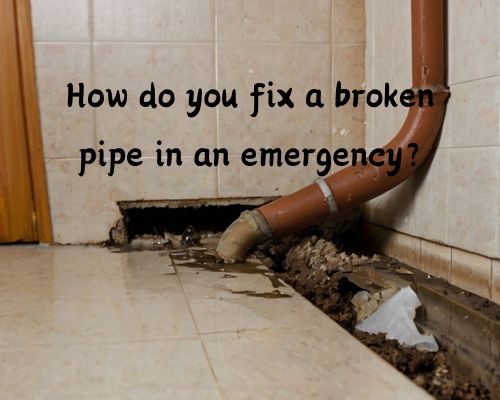
Essential Steps and Tips
A broken pipe can be a homeowner’s worst nightmare. It can cause significant water damage and disruption to your daily life.
In an emergency situation, it’s crucial to know how to act quickly. This will help you minimise damage and restore your water supply.

The key steps include shutting off the water, draining the pipes, and making a temporary or permanent repair.
When faced with a plumbing emergency, the first thing you need to do is locate and turn off the main water supply. This stops further water flow and helps contain the problem.
Depending on the severity and location of the break, you might need to cut out the damaged section, smooth the edges, and replace it with new pipe.
Effective emergency repair techniques include using a pipe repair clamp or an epoxy putty to temporarily seal the leak. These methods buy you time until a professional like Dean Owens from Plumber Warragul can provide a permanent solution.
Identifying and Responding to the Emergency
When you face a burst pipe emergency, responding quickly and effectively is essential to minimise water damage and potential hazards.
Locating the Broken Pipe
The first step is to find the source of the leak. Look for visible signs of water flowing or pooling, damp spots on walls or ceilings, and reduced water pressure.
If the burst pipe is not immediately visible, you may need to check behind walls or under floors. Using a flashlight can help you see in hard-to-reach areas.
You may also listen for the sound of rushing water, which can guide you to the exact location. Identifying the pipe quickly allows you to proceed with emergency steps.
Shutting Off the Water Supply
Once you find the burst pipe, immediately shut off the water supply to prevent further flooding.
Locate your home’s main shut-off valve, typically found near the water meter or where the main water line enters the house. Turn the valve clockwise to shut it off completely.
If you’re unsure of the main shut-off valve’s location, look for smaller valve switches near the site of the burst pipe.
Shutting off the water supply stops the flow and limits the extent of water damage.
Preventing Water Damage
After shutting off the water, focus on preventing further damage.
Move furniture and valuables away from the affected area to safe locations. Use towels, mops, or water-absorbing materials to soak up excess water.
Placing buckets under active leaks can also help contain the spread.
Ensure all electrical appliances in the vicinity are unplugged to avoid electrical hazards.
Consider using fans or dehumidifiers to dry out the area and reduce moisture levels, which can prevent mould growth.
Contacting an Emergency Plumber
Once you have limited the immediate impact of the burst pipe, contact a professional emergency plumber, see Dean Owens from Plumber Warragul.
Reaching out to a local plumber ensures a prompt response. Be prepared to provide detailed information about the location and severity of the burst pipe.
While waiting for the plumber, avoid any additional plumbing activities, as they could exacerbate the issue.
Emergency plumbing services will provide the expertise and tools needed to fix the pipe and mitigate further damage.
Temporary and Permanent Repair Solutions
Fixing a broken pipe involves immediate steps for temporary repairs and more thorough methods for permanent fixes.
Proper material selection and execution are essential for both types to ensure safety and functionality.
Implementing a Quick Fix
When a pipe bursts, immediate action is critical to prevent extensive water damage.
Turn off the water supply to the damaged pipe right away. For a quick fix, you can use epoxy putty or duct tape.
Epoxy putty provides a watertight seal. Knead the putty before applying it to the cleaned and dried area of the pipe.
Alternatively, wrap the leaking section with duct tape for a temporary solution. Both methods will stop the leak long enough to plan a permanent repair.
Selecting the Right Materials for Temporary Repairs
Selecting materials for a temporary repair involves careful consideration.
Common materials include rubber patches, hose clamps, and pipe tape.
Rubber patches paired with hose clamps can cover the leak securely. Wrap the rubber around the leak and fasten it with clamps.
Pipe tape is another effective solution; wrap it tightly around the entire pipe diameter for a temporary seal.
It’s essential to ensure all materials are rated for plumbing use to avoid further damage.
Executing Permanent Repairs
Permanent repairs generally involve replacing the damaged section of pipe.
Tools like pipe cutters and a hacksaw are necessary to remove the broken segment.
For copper pipes, sweating a new piece into place using solder is highly effective.
If the damaged pipe is made of PVC, use a slip coupling to replace the section.
Measure and cut the replacement piece to fit snugly. Apply PVC cement to both the coupling and the new pipe section for a durable repair.
Professional Assessment and Restoration
After implementing either a temporary or permanent repair, it’s wise to have a professional assess the job. A licensed plumber can inspect for corrosion. They can also check for hidden damage or other issues that may not be easily visible.
Professionals bring specialised tools and expertise. This ensures the repair is not only done correctly but is also sustainable. Scheduling a professional assessment helps avoid future pipes bursting. It also guarantees your plumbing system’s longevity.





